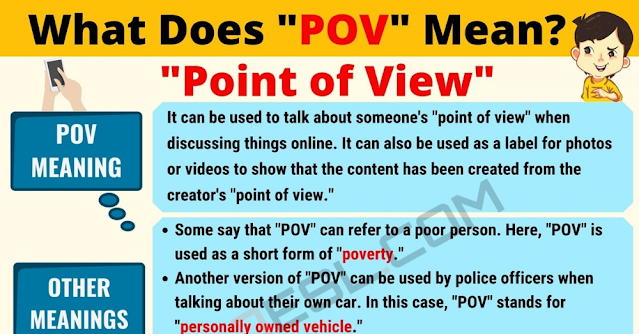In the realm of storytelling and literature, Point of View (POV) is a crucial element that shapes the narrative and engages readers on a deeper level. Whether you're an aspiring writer or an avid reader, grasping the concept of POV is essential for a richer literary experience.
Defining POV: What Does Point of View Mean?
Point of View refers to the vantage point or perspective from which a story is narrated. It serves as the lens through which readers witness the events, experience the emotions, and connect with the characters. Different POVs offer distinct insights into the narrative, influencing the overall tone and reader's engagement.
Types of Point of View: Exploring Narratorial Perspectives
1. First Person POV: "I" Narrator
- This POV involves a narrator who directly participates in the story, using "I" to convey personal experiences and thoughts. It provides an intimate connection with the protagonist's inner world.
2. Second Person POV: "You" Narrator
- Uncommon in fiction, the second person directly addresses the reader as "you." It creates a unique, immersive experience, pulling the reader into the narrative as an active participant.
3. Third Person Limited POV: External Observer
- The narrator is an external entity, aware of the characters' thoughts and feelings but limited to one character's perspective. It offers a balance between intimacy and broader storytelling.
4. Third Person Omniscient POV: All-Knowing Narrator
- The narrator has unlimited knowledge of characters' thoughts, emotions, and events. This POV provides a comprehensive view but may distance readers from individual characters.
5. Objective POV: Neutral Observer
- The narrator remains a detached observer, presenting only observable actions and dialogues without delving into characters' inner thoughts. This style fosters a sense of objectivity.
Impact of POV on Reader Experience: Crafting Narrative Depth
Choosing the right POV is a strategic decision that influences how readers perceive and engage with a story. First-person narration creates immediacy and emotional connection, while third-person allows for a broader exploration of multiple characters.
SEO-Friendly Tips for Point of View in Writing
1. Use Keywords Naturally:
- Incorporate relevant keywords seamlessly within your content to enhance search engine visibility. Include phrases related to the significance of POV in storytelling.
2. Provide Valuable Information:
- Offer insights into how POV shapes narrative dynamics and affects reader immersion. Quality content attracts search engines and keeps readers engaged.
3. Optimize Meta Descriptions:
- Craft meta descriptions that succinctly convey the article's focus on POV. Use compelling language to entice clicks from users interested in narrative techniques.
In conclusion, Point of View is a literary powerhouse that adds depth and resonance to storytelling. Whether you're a writer seeking to refine your craft or a reader delving into a new narrative, understanding and appreciating different POVs enriches the literary experience.







![Akta Kerja 1955 [Pindaan 2022] Berkuatkuasa 1 Januari 2023](https://blogger.googleusercontent.com/img/b/R29vZ2xl/AVvXsEjSTsX1-snNIQp9Zyk-pU3QuEdH3dp1A0cTxTMi6pPak70KzRCl2HZFuvpwYFe7jXxYrmmri1m8FpLvRVEH6fQ_VZaiozokhhDzyfIVMm0b0P6ci6JDb8Ud1mJixsCvqkgd81FNaQEl5o5u_4Kw4yMWlEOZvS4PyVmKy-Df0upf5_142Cs-Cn47jQaezg/w680/akta-kerja-2022.jpg)
0 Comments